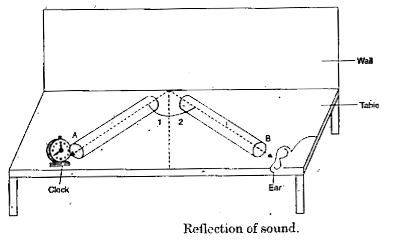Take two identical pipes, as shown in Fig 12.23. You can make the pipe using chart paper. The length of the pipes should be sufficiently long as shown paper. Arrange them on a table near a wall. Keep a clock near the open end of one of the pipes, say pipe A and try to hear the sound of the clock through the other pipe. Put a playwood sheet between the two tubes perpendicular to the wall. This does not allow the direct hearing of the ticking sound of the clock. Ajust the position of the pipes so that you can best hear the sound of the clock.

Now measure the angles of incidence and reflection and see the relationship between the angles.
We will find that angle of incidence (1) and angle of reflection (2) are equal
Related Playlists
Similar Questions
If you clap on one end of a long steel pipe you will hear two distinct sounds on the other end of the pipe. Explain.
View SolutionThe second overtone of a closed organ pipe is in unison with the fourth overtone of the open organ pipe. Calculate the ratio of length of the two pipes.
View SolutionIf an observer places his ear at the end of a long pipe, he can hear two distinct echoes when the pipe is hammered at the other end. Explain.
View SolutionPipe A alone can fill a tank in 8 hours. Pipe B alone can fill it in 6 hours. If both the pipes are opened and after 2 hours pipe A is closed, then the other pipe will fill the tank in
View SolutionPipe A alone can fill a tank in 8 h. Pipe S alone can fill it in 6 h. If both the pipes are opened and after 2 h pipe A is closed, then the other pipe will fill the tank in
View SolutionCompare the length of a closed organ pipe and an open organ pipe, if the second overtone of the open pipe is unison with the second overtone of the closed organ pipe.
View SolutionCompare the length of a closed organ pipe and an open organ pipe, if the second overtone of the open pipe is unison with the second overtone of the closed organ pipe.
View SolutionCompare the length of a closed organ pipe and an open organ pipe, if the second overtone of the open pipe is unison with the second overtone of the closed organ pipe.
View SolutionKeeping the length of the pipe constant if diameter of the pipe increased twice , then frequency of pipe will
View SolutionA person blows into open- end of a long pipe. As a result, a high pressure pulse of air travel down the pipe. When this pulse reaches the other end of the pipe,
View Solution

